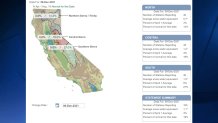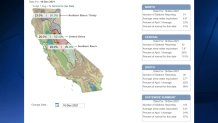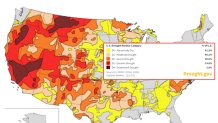San Diego, and most of the state, has been hurting for rain and we finally got some. Experts and weather agencies say that rain helps our water storage situation in the short term, but as the data shows, we've got a long way to go until we start swimming out of the drought.
The big rainstorm that soaked San Diego County on Tuesday dumped up to two inches over coastal and valley communities, and about a half-inch in the desert, according to the National Weather Service.
The storm helped bring Southern California close to seasonal averages for rainfall, according to the NWS, but if we have another extended period without precipitation we'll fall right back into a hole.
Get San Diego local news, weather forecasts, sports and lifestyle stories to your inbox. Sign up for NBC San Diego newsletters.
San Diego has seen slightly higher-than-average rainfall, according to the NWS. This map from the National Integrated Drought Information System (NIDIS) shows most of San Diego County's coast is behind track, but some inland and mountain regions are picking up the slack.

One short-term benefit of the recent rainstorm is the impact it will have on water demand down the line, according to Goldy Herbon with the San Diego County Water Authority said.
Local
Following big storms, San Diegans can turn off their irrigation systems for one to two weeks, and the county will draw less from stored water sources, like our reservoirs.
"The beneficial impact that turning off your sprinklers will have is that it'll keep the water that is stored in our reservoirs now, and we'll be able to tap into that source in times of major need in the summer -- our summer months and our summer season is just getting more and more expanded," Herbon said.
In October, the Water Authority asked San Diegans to cut back water usage by 10%, and Governor Gavin Newsom extended a drought emergency to San Diego County and asked Californians to voluntarily cut back water use by 15%.
What Herbon says will really help float San Diego and the entire state out of current drought conditions is snowpack.
"This water will help us all, but what's critical is that the snowpack starts to develop and holds through the winter. So we have three more months to go, and we need a few more storms to kind of get us in decent shape," she said.
Figures from the state Department of Water Resources show that just a week ago, the Sierra Nevada Mountain Range was far behind schedule when it comes to average snowfall relative to that time of year.
Snowpack in the Sierras is broken into three zones: Northern, Central and Southern. On Dec. 9, the zones had only seen a fraction of what they typically see by that date. The Northern zone was short 86%, followed by the Central zone at 82% and the Southern zone at 73%.

Fast forward a week to Dec. 16, and all three zones are either above or close to meeting averages. The Northern zone is just 9% shy while the Southern zone is only 1% short. In between, the Central zone is in good shape at 101%

Just like we saw with seasonal rainfall totals, if the Sierra Nevada sees an extended period without snow then those percentages will slowly drop and the three zones will fall below their marks.
So, to reiterate, this week of storms up and down the state has been great for our short-term outlook, but when you start looking a little further down the road you see how much more help we need.
The NIDIS U.S. Drought Monitor shows San Diego County in moderate drought. Much of California and parts of most western states have been placed in elevated categories, including severe, extreme and exceptional.

The NIDIS's Climate Prediction Center also keeps track of the Seasonal Drought Outlook, or how likely conditions across the country are to improve or worsen, and color-codes regions based on expectations three months from now.
Looking at Southern California, it's clear the region needs a lot more rain and snow.

The NIDIS offered this note about drought conditions across the entire country for the week of Dec. 8 to Dec. 14:
"Amidst the wild and devastating weather week, drought mostly held at status quo. The West saw some improvements, and the Southern Plains saw degradations, with mostly small changes elsewhere. As of December 14, 2021, 46.2% of the U.S. and 55.1% of the lower 48 states are in drought."



